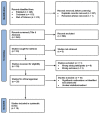The Incidence and Associated Risk Factors of Contrast-Induced Nephropathy after Contrast-Enhanced Computed Tomography in the Emergency Setting: A Systematic Review
- PMID: 35743857
- PMCID: PMC9224719
- DOI: 10.3390/life12060826
The Incidence and Associated Risk Factors of Contrast-Induced Nephropathy after Contrast-Enhanced Computed Tomography in the Emergency Setting: A Systematic Review
Abstract
Iodinated contrast media (ICM) during contrast-enhanced computed tomography (CECT) in the emergency department (ED) is essential to diagnose acute conditions, despite risks of contrast-induced nephropathy (CIN) development and its associated complications. This systematic review aims to evaluate the incidence of CIN and CIN-induced complications, and to explore the relevance of classical risk factors for CIN among ED patients receiving ICM. PubMed, Cochrane, and Web of Science were used on 30 August 2021 to search for peer-reviewed English articles reporting on CIN incidence among ED patients aged ≥18 years who underwent an intravenous CECT. The inclusion criteria included studies that were in English, peer-reviewed, and involved ED patients aged ≥18 years who underwent single intravenous CECT. Studies on intra-arterial procedures and preventive strategies, meta-analyses, clinical guidelines, review articles, and case reports were excluded. The JBI critical appraisal checklist was applied to assess the risk of bias. In total, 18 studies were included wherein 15 were retrospective studies while three were prospective studies. We found a relatively higher CIN incidence in the ED, with variations owing to the CIN definitions. Several classical risk factors including acute hypotension remain linked to CIN onset in ED settings unlike factors such as age and diabetes. While risk of adverse renal events due to CIN is low, there is higher risk of CIN-induced mortality in the ED. Therefore, with the higher incidence of CIN and CIN-induced mortality rates in the ED, ICM administration during CECT in the ED should still be clinically justified after assessing both benefits and risks.
Keywords: contrast media; contrast-enhanced computed tomography; contrast-induced nephropathy; emergency department.
Conflict of interest statement
The authors declare no conflict of interest.
Similar articles
-
Risk factors for acute kidney injury in the elderly undergoing contrast-enhanced computed tomography in the emergency department.J Chin Med Assoc. 2013 May;76(5):271-6. doi: 10.1016/j.jcma.2013.01.007. Epub 2013 Mar 21. J Chin Med Assoc. 2013. PMID: 23683260
-
Contrast induced nephropathy in patients undergoing intravenous (IV) contrast enhanced computed tomography (CECT) and the relationship with risk factors: a meta-analysis.Eur J Radiol. 2013 Sep;82(9):e387-99. doi: 10.1016/j.ejrad.2013.04.029. Epub 2013 May 25. Eur J Radiol. 2013. PMID: 23711425
-
Is the risk of contrast-induced nephropathy a real contraindication to perform intravenous contrast enhanced Computed Tomography for non-traumatic acute abdomen in Emergency Surgery Department?Acta Biomed. 2018 Dec 17;89(9-S):158-172. doi: 10.23750/abm.v89i9-S.7891. Acta Biomed. 2018. PMID: 30561410 Free PMC article.
-
Evaluating the Effectiveness of Pretreatment With Intravenous Fluid in Reducing the Risk of Developing Contrast-Induced Nephropathy: A Systematic Review and Meta-Analysis.Cureus. 2022 May 8;14(5):e24825. doi: 10.7759/cureus.24825. eCollection 2022 May. Cureus. 2022. PMID: 35693368 Free PMC article. Review.
-
Association between contrast-induced nephrotoxicity and contrast enhanced computed tomography followed by endoscopic retrograde cholangiopancreatography.Eur J Radiol. 2020 Aug;129:109074. doi: 10.1016/j.ejrad.2020.109074. Epub 2020 May 19. Eur J Radiol. 2020. PMID: 32473539
Cited by
-
Contrast-induced acute kidney injury and its contemporary prevention.Front Cardiovasc Med. 2022 Dec 6;9:1073072. doi: 10.3389/fcvm.2022.1073072. eCollection 2022. Front Cardiovasc Med. 2022. PMID: 36561776 Free PMC article. Review.
-
Rosiglitazone Alleviates Contrast-Induced Acute Kidney Injury in Rats via the PPARγ/NLRP3 Signaling Pathway.Dis Markers. 2022 Oct 3;2022:4158692. doi: 10.1155/2022/4158692. eCollection 2022. Dis Markers. 2022. Retraction in: Dis Markers. 2023 Jul 26;2023:9826918. doi: 10.1155/2023/9826918. PMID: 36225198 Free PMC article. Retracted.
-
Predictive value of combining urinary N-acetyl-β-D-glucosaminidase and serum homocysteine for contrast-induced nephropathy in patients after percutaneous coronary intervention.Front Cardiovasc Med. 2024 Aug 20;11:1423836. doi: 10.3389/fcvm.2024.1423836. eCollection 2024. Front Cardiovasc Med. 2024. PMID: 39228665 Free PMC article.
-
A Feasibility Study to Evaluate Replacing Conventional Computed Tomography at 120 KVP with Low Radiation Dose and Low Iodine Intake Based on Body Mass Index-Adapted Abdominal Computed Tomography Angiography in 291 Patients.Med Sci Monit. 2023 May 3;29:e939228. doi: 10.12659/MSM.939228. Med Sci Monit. 2023. PMID: 37131306 Free PMC article.
-
Risk Score for Predicting Acute Kidney Injury from Contrast-Enhanced Computed Tomography (Pre-Computed Tomography Acute Kidney Injury Score): Training and Validation from Retrospective Cohort.Kidney360. 2025 Jan 1;6(1):49-57. doi: 10.34067/KID.0000000623. Epub 2024 Oct 17. Kidney360. 2025. PMID: 39418104 Free PMC article.
References
-
- Maxwell S., Ha N.T., Bulsara M.K., Doust J., Mcrobbie D., O’Leary P., Slavotinek J., Moorin R. Increasing Use of CT Requested by Emergency Department Physicians in Tertiary Hospitals in Western Australia 2003–2015: An Analysis of Linked Administrative Data. BMJ Open. 2021;11:e043315. doi: 10.1136/bmjopen-2020-043315. - DOI - PMC - PubMed
-
- Bellolio M.F., Heien H.C., Sangaralingham L.R., Jeffery M.M., Campbell R.L., Cabrera D., Shah N.D., Hess E.P. Increased Computed Tomography Utilization in the Emergency Department and Its Association with Hospital Admission. West. J. Emerg. Med. 2017;18:835–845. doi: 10.5811/westjem.2017.5.34152. - DOI - PMC - PubMed
-
- American College of Radiology ACR Appropriateness Criteria®|American College of Radiology. [(accessed on 11 February 2022)]. Available online: https://www.acr.org/Clinical-Resources/ACR-Appropriateness-Criteria.
-
- Davenport M.S., Perazella M.A., Yee J., Dillman J.R., Fine D., McDonald R.J., Rodby R.A., Wang C.L., Weinreb J.C. Use of Intravenous Iodinated Contrast Media in Patients with Kidney Disease: Consensus Statements from the American College of Radiology and the National Kidney Foundation. Radiology. 2020;294:660–668. doi: 10.1148/radiol.2019192094. - DOI - PubMed
Publication types
LinkOut - more resources
Full Text Sources


